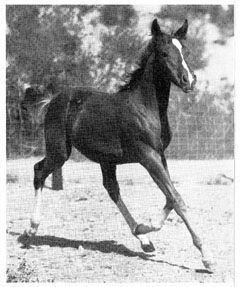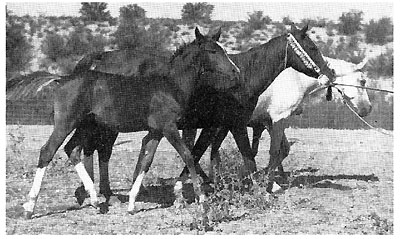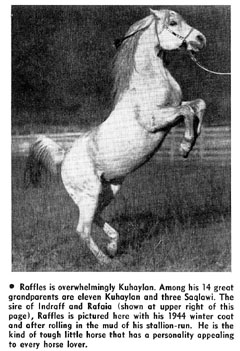| The old studbooks of the Arabian Horse Club of America
and of the Arab Society of England, as well as Wheatherby and the Jockey
club registrations, left us the answer to our questions as to which strains
(on sire's and dam's side) Arabian horses in America and England belong,
though their offspring may not have been registered any longer as to their
strain descent in the latest studbooks.
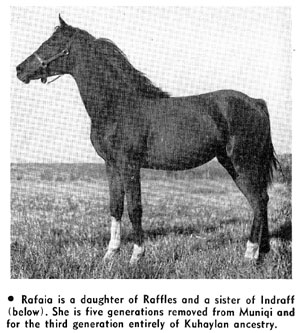
Rafaia is a daughter of Raffles and a sister of
Indraff (below). She is five generations removed from Muniqi and for the
third generation entirely of Kuhaylan ancestry.
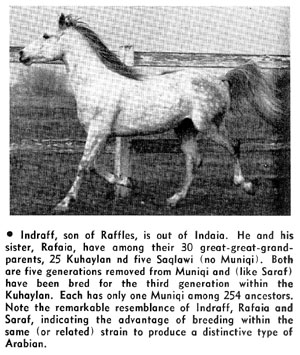
Indraff, son of Raffles, is out of Indaia. He and
his sister, Rafaia, have among their 30 great-great-grandparents, 25 Kuhaylan
nd(sic) five Saqlawi (no Muniqi). Both are five generations removed from
Muniqi and (like Saraf) have been bred for the third generation within
the Kuhaylan. Each has only one Muniqi among 254 ancestors. Note the remarkable
resemblance of Indraff, Rafaia and Saraf, indicating the advantage of breeding
within the same (or related) strain to produce a distinctive type of Arabian.
The most important ancestors of any Arabian horse (as far as those
powerful tendencies are concerned which transmit good qualities and faults
as well) are the eight great grandparents. They hold the "key"
to the size, weight, shape, conformation, type, Arabian characteristics,
and temperament of our horse. These eight ancestors are still within that
focal-point where influence of pure (or related) bloodlines (strains)
count most. When we go beyond to the fourth, fifth, or sixth generation,
the original bloodlines are usually so "thinned" out and so diffused,
that they become distant "constellations" (as the Bedouins call
them) and are not so impressive and influential anymore upon the picture
which we behold in the mosaic-like design formed by the various colors
of the different strains in a pedigree.
Diffusion in a pedigree increases as follows:
1st generation 2 = 1 sire and 1 dam (total ancestors 2)
2nd generation 4 = 2 grandsires and 2 grand dams (total ancestors
6)
3rd generation 8 = 4 great-grand sires and 4 great-grand dams (total
ancestors 14). These eight great-grandparents wield the greatest influence.
They have to be pure (or related) in strain to produce an outstanding great-grandson
or great-grand-daughters.
4th generation 16 = 8 Great-great grand sires and 8 great-great-grand
dams (total ancestors 30)
5th generation 32 = 16 great-great-great-grand sires and 16 great-great-great-grand
dams (total ancestors 62)
6th generation 64 = 32 great-great-great-great-grand sires and 32
great-great-great-great-grand dams (total ancestors 126)
Pedigrees are mathematical "problems," but not difficult
to analyze. We should realize, however, that the purer we breed the more
simplified becomes our task, and the stronger, more beautiful, more distinctive,
and in every respect more perfect and harmonious the result (in our case
the Arabian offspring).
Nature still designs and creates in her own way with the aid of laws
which we have incorporate into our sciences of space and number and have
applied to physical research (and thus to animal husbandry too!). We have
found that no human hand or mind can alter these perfect rules--rules which
work "mysteriously" also within the strains or bloodlines of
a pedigree (and thus in what this pedigree represents to us: a horse).
We may apply these unseen, but controlling (and therefore reliable) powers
and use them either for benefit or for loss to ourselves. We may abuse
them, and produce not only inferior creatures, but freaks and mongrels.
We may also recognize our own (or somebody else's) mistakes and by retracing
steps patiently and faithfully within these mathematical laws and within
the order (harmony) of a particular pattern (in our case it would be Arabian
strain-breeding) reach again the well balanced perfection of "The
Original."
Analysing the pedigree of an Arabian horse we should ask the following
questions:
1. To which strain (colors) do the eight great-grand parents of your
horse belong?
2. which strain (color) is overwhelmingly present? If none is predominant,
add the blue and red together and find out how much they outweigh the brown
(Muniqi).
3. What strain is the dam? She gives size and frame to her offspring,
but if a Muniqiyah and the other seven great-grandparents are Kuhaylan
or Saqlawi, she does not transmit the angular outlines of body and
drooping hind quarters. In such a case the Muniqiyah mare produces a taller
Arabian with more bone, though lacking the extremely Arabian head and some
of the elegant tail carriage.
4. How close appears the first Muniqi? Any Muniqi appearing within
the first three generations (total 14 ancestors) still influences the offspring.
If not more than one Muniqi appears in four generations (--30 ancestors),
the Muniqi influence is practically out. Any additional Muniqi among the
first 30 (direct) ancestors adds length and coarseness (plain features)
to body and head (small eyes, narrowness between jowls; long, straight
profile of face). In the sixth generation (126 ancestors) the total number
of Muniqi, which have practically no influence then, should not exceed
six.
5. Are the first 30 (direct) ancestors (== four generations) of mixed
strains, but without any Muniqi? The result will be a very harmonious,
well balanced horse with a fine type (Arabian) head and good tail carriage.
More muscle and power if Kuhaylan predominates; more graceful (slender)
lines if Saqlawi.
|
